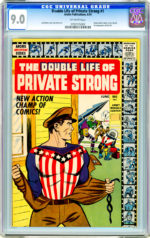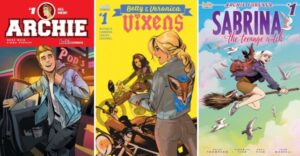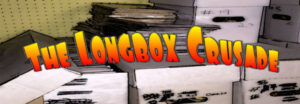FANZINE: LANCELOT STRONG, SECOND GENERATION SHIELD
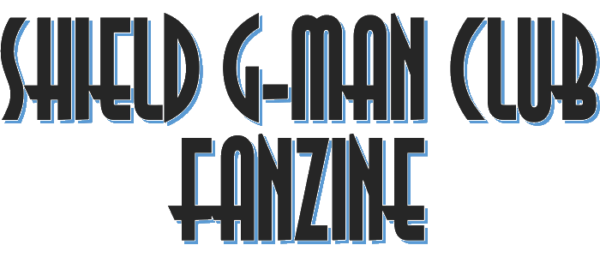
by Lou Mougin
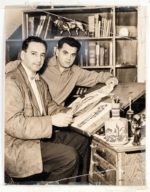 Since creating Captain America in 1941, Joe Simon and Jack Kirby never seemed far away from patriotism.
Since creating Captain America in 1941, Joe Simon and Jack Kirby never seemed far away from patriotism.
Why not? Kids needed an embodiment of America to inspire them against Hitler. MLJ had done it first with the Shield. Cap was close behind, with Joe and Jack doing his first ten issues and a couple of All-Winners Comics stories before heading over to DC Comics, where they semi-cloned him as The Guardian in the Newsboy Legion series. The Shield petered out in the postwar era, and Captain America made it to 1949 before ending in the superhero bust that year.
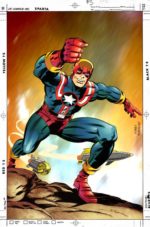 In the early Fifties, Simon and Kirby produced the shortlived Fighting American for Prize, a little-bought but well-loved Cold War satire with a Cap figure for the anti-Communist era. The stories are still fun to read but Fighting A has never been revived with much success.
In the early Fifties, Simon and Kirby produced the shortlived Fighting American for Prize, a little-bought but well-loved Cold War satire with a Cap figure for the anti-Communist era. The stories are still fun to read but Fighting A has never been revived with much success.
Then, in 1959, with DC’s The Flash paving the way for the second superhero boom, Archie comics, nee’ MLJ, decided to try them again. A safe bet was the Shield, probably their most popular Golden Age hero. Plus, of course, whatever else S&K could come up with, which included The Fly.
The result was a comic dated June 1959, and its title was The Double Life of Private Strong.
A cover blurb designated him “The new action champ of comics!” and a strip drawn to look like movie cels ran across the top and side of the cover, showing our hero in stop-motion action as he beat up on spies and then changed into an Army uniform and saluted. The main picture depicted said Private Strong doffing his G.I. gear and showing a red-and-white striped chest emblem topped with stars, and what showed of a purple (probably intended to be blue) shirt below it. He was looking to the right, where a couple of space aliens were trying to sabotage a missile base and shooting at two soldiers headed for them. Whoever Private Strong was, he had his mission cut out for him.
Back in ’59, America was a much more conservative country than it became in the post-Kennedy years. Nobody was questioning the menace of Soviet Communism, and patriotism was the rule of the day. If you’d spoken out on behalf of the Commies, you might as well have been defending Nazis during World War II. That was the world that Lancelot Strong (the ultimate heroic name) walked into, and he inhabited it well.
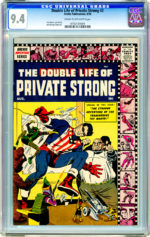 The intro on page one showed us a great central Kirby figure of Strong in mask and red-white-and-blue uniform. On the sides, he was shown generating and hurling electrical bolts, dodging gunfire, being encased in a huge cube of ice, peering with his super-eyes through the darkness, and swimming beside sharks. A final caption gave us his nom de guerre: “Begin the amazing, spine-tingling adventures of The Shield—a new and different type of hero who packs the punch of a hydrogen bomb!”
The intro on page one showed us a great central Kirby figure of Strong in mask and red-white-and-blue uniform. On the sides, he was shown generating and hurling electrical bolts, dodging gunfire, being encased in a huge cube of ice, peering with his super-eyes through the darkness, and swimming beside sharks. A final caption gave us his nom de guerre: “Begin the amazing, spine-tingling adventures of The Shield—a new and different type of hero who packs the punch of a hydrogen bomb!”
The Shield was back! Well, not the original, for sure…but a retooled version for the Cold War.
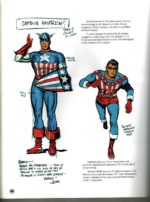 The splash of the first story showed the Mark II Shield avoiding the bullets of Communist soldiers while escaping them. Then we segued into the story proper: a couple of KGB types mulled over a secret mission on which they had dispatched one Agent Four, to deal with a capitalist enemy named Fleming. Then the scene switched to America, where two scientists were visiting Professor Malcolm Fleming (for some reason, called Malcolm Strong in a caption) at his futuristic, gadget-filled lab. It looked like something out of Reed Richards’s wizard’s-den in the mid-Sixties Fantastic Four and, truthfully, Kirby’s art was better here than his early FF ventures. The visitors wanted to know the contents of Fleming’s “Secret Room,” and they would, along with us.
The splash of the first story showed the Mark II Shield avoiding the bullets of Communist soldiers while escaping them. Then we segued into the story proper: a couple of KGB types mulled over a secret mission on which they had dispatched one Agent Four, to deal with a capitalist enemy named Fleming. Then the scene switched to America, where two scientists were visiting Professor Malcolm Fleming (for some reason, called Malcolm Strong in a caption) at his futuristic, gadget-filled lab. It looked like something out of Reed Richards’s wizard’s-den in the mid-Sixties Fantastic Four and, truthfully, Kirby’s art was better here than his early FF ventures. The visitors wanted to know the contents of Fleming’s “Secret Room,” and they would, along with us.
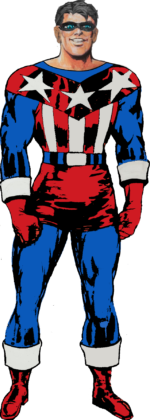 First, though, Fleming explained that “It is known that man uses only one-tenth of his brain power—the other nine tenths are—unexplored territory!” Said theory holds a lot less water these days, but not back then. Speculating on what power humans might have if they harnessed the remaining nine-tenths, Fleming pushed a button on the wall, and it rose up, revealing a toddler in a glass room. The boy had a big helmet on his head with a couple of lights on the back, and he was happily playing with blocks and a pop-up doll, books strewn on the floor and the bed looking like it was recently slept-in. A proto-Baby Einstein.
First, though, Fleming explained that “It is known that man uses only one-tenth of his brain power—the other nine tenths are—unexplored territory!” Said theory holds a lot less water these days, but not back then. Speculating on what power humans might have if they harnessed the remaining nine-tenths, Fleming pushed a button on the wall, and it rose up, revealing a toddler in a glass room. The boy had a big helmet on his head with a couple of lights on the back, and he was happily playing with blocks and a pop-up doll, books strewn on the floor and the bed looking like it was recently slept-in. A proto-Baby Einstein.
“Using my boy, Roger, as an experimental subject has not harmed him in the least. He lives a germ-free existence and receives micro-electrical stimuli through that helmet—which has been developing his hidden powers since infancy!” This was Fleming’s claim, but the two scientists didn’t buy it. They were going to report him to the authorities and made no bones about it. To avoid being separated from his child, Malcolm Fleming took off with him in a futuristic truck before they could return.
But Agent Four, who looked like a Vincent Price knock-off and sported gloves, an opera cape, and a cane, was on the job. He directed two gangster-like Communists to overtake Fleming’s truck. As luck would have it, they ran Fleming off the road and his truck plummeted to its doom off the side of a mountain. Figuring the scientist was dead and his notes unrecoverable, the spies left.
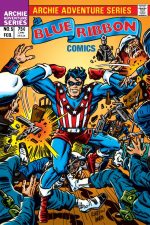 They hadn’t counted on Roger. Still wearing his helmet, Roger Fleming crawled from the wreckage, calling for his daddy. He wandered off, lost in that proverbial world he never made, and soon fell into the hands of a farmer named Abel Strong and his wife, Martha. The two adopted the boy and named him Lancelot. As for the helmet, they didn’t know what to make of it. That ended the first part of the story.
They hadn’t counted on Roger. Still wearing his helmet, Roger Fleming crawled from the wreckage, calling for his daddy. He wandered off, lost in that proverbial world he never made, and soon fell into the hands of a farmer named Abel Strong and his wife, Martha. The two adopted the boy and named him Lancelot. As for the helmet, they didn’t know what to make of it. That ended the first part of the story.
This was, thematically at least, edging too close to Superman territory for comfort. Prof. Fleming could be seen as a stand-in for Jor-El, Roger for his son Kal, and Abel and Martha as substitutes for Jonathan and Martha Kent. It’s doubtful Jack and Joe had any such thing in mind when they created the character. But DC could suggest it was. Before long, they did.
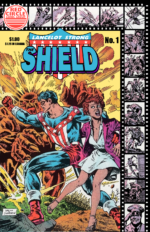 Anyway, the second story showed Lance Strong in full Shield regalia on the splash, headed for a megacephalic stone-being who was burning things with its heat-vision. “Spawn of the X-World” was the title, and it started more than a few years after the earlier one ended. In the opening sequence, something hit a newly-orbiting Sputnik, knocking it off-course. The satellite and its rider crash-landed in Fairfield County, U.S.A., precisely where Lance Strong was living, but in a logging area. The being who rode in with it stayed in the “nest” of twisted metal for days and began to grow—and grow—
Anyway, the second story showed Lance Strong in full Shield regalia on the splash, headed for a megacephalic stone-being who was burning things with its heat-vision. “Spawn of the X-World” was the title, and it started more than a few years after the earlier one ended. In the opening sequence, something hit a newly-orbiting Sputnik, knocking it off-course. The satellite and its rider crash-landed in Fairfield County, U.S.A., precisely where Lance Strong was living, but in a logging area. The being who rode in with it stayed in the “nest” of twisted metal for days and began to grow—and grow—
Days later, a logging camp was menaced by a huge grey monster whose eyes shot firebolts and started a forest fire. Cut to: Lancelot Strong and his pal Spud, exploring the wreckage of Fleming’s truck. Lance ducked into the debris for a while, long enough to make his friend call out anxiously for him. “What are you doing there? Are you all right?”
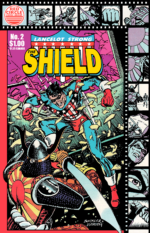 Lance showed his head, shoulders, and hands. He was in the red, white, and blue costume for the first time, and he was smiling. “Never felt better, Spud!”
Lance showed his head, shoulders, and hands. He was in the red, white, and blue costume for the first time, and he was smiling. “Never felt better, Spud!”
The costumed youth admitted that he couldn’t help putting on the outfit once he saw it, and a book he had retrieved said it was made for someone with special powers who would protect all mankind. Putting on the eye-mask, Lance said it felt like it belonged to him, and he was going to keep it.
But the flames of the forest fire drew their attention, and Lance catapulted in that direction with a leap beyond the ken of normal humanity. The work crew was trying and failing to hold off the alien creature. This, obviously, was a job for a super-hero, and Lancelot Strong filled the bill.
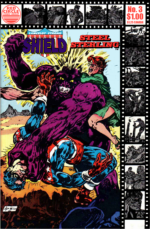 Acting on “Some inexplicable instinct,” Lance blasted the being with bolts from his hands. It seared the air around the creature but failed to stop him. In return, the alien reversed his eye-blasts to hit the humans with cold waves and turned Lance into a living snowman.
Acting on “Some inexplicable instinct,” Lance blasted the being with bolts from his hands. It seared the air around the creature but failed to stop him. In return, the alien reversed his eye-blasts to hit the humans with cold waves and turned Lance into a living snowman.
Seemingly unstoppable, the monster from space melted a police motorcycle with his hand, and the cops feared disaster should he reach a city. But Lancelot’s internal thermostat turned up his body heat and he melted free from the ice trap. All of this, mind you, just minutes after he donned the costume for the first time.
In a showdown, Lance exhibited Flash-like speed, running around the alien fast enough to create a vortex. A crack of thunder was heard, and Lance, recovering, handed off the miniaturized, hand-sized creature to the police chief. When Lance had created a vacuum, the monster returned to its original tiny size, and the cop opined it was dead.
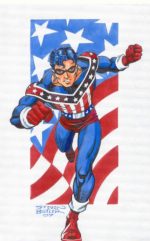 Then Lance ran off, as all good superheroes must, and in his wake, someone asked his name. “Shield will do!” he replied. “Just call me the Shield!”
Then Lance ran off, as all good superheroes must, and in his wake, someone asked his name. “Shield will do!” he replied. “Just call me the Shield!”
It was a rousing origin, but there was a price to be paid. In the last two panels, changed back to his civilian identity, Lance saw Spud being loaded into an ambulance. Another policeman said that he had been caught in the forest fire, and he was a goner. Sadly, Lance dedicated himself to learning the Shield’s powers, and to use them to benefit all mankind.
After a two-page short that introduced the Fly, Simon and Kirby offered “Mystery of the Vanished Wreckage!” We learned it had been fifteen years since the death of Prof. Fleming, and Lancelot Strong was inevitably drawn back to the wreckage site. Unfortunately, so were Agent Four and his minions, who rifled the remains of the van and found Flemings’ notes. They prepared to hand it off to their Commie masters by way of an approaching submarine.
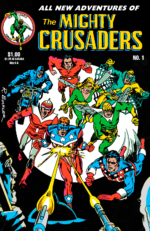 Lance, however, used what amounted to super-memory to recall his childhood, and saw the image of his father showing him the Shield costume. “When you are old enough to wear this, you’ll be wise enough to use your powers as a shield against the evil forces that threaten mankind!” Lance mused, “Now that I know who I am, I’ll be what you hoped for—a Shield against evil!”
Lance, however, used what amounted to super-memory to recall his childhood, and saw the image of his father showing him the Shield costume. “When you are old enough to wear this, you’ll be wise enough to use your powers as a shield against the evil forces that threaten mankind!” Lance mused, “Now that I know who I am, I’ll be what you hoped for—a Shield against evil!”
After finding out someone had ransacked the wrecked truck, the Shield got on the job, intercepted Agent Four and the Communist sub crew as they were about to take off, and piled into them in full-tilt action as only Jack Kirby could draw it. The briefcase containing his father’s notes was knocked into the water. The Shield, dodging cannon shells and bullets, plunged into the sea, retrieved it, surfaced to face a machine-gun barrage and then, unbelievably—well, let Kirby tell it:
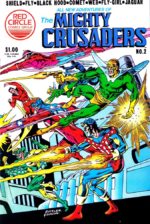 “A lightning molecular rearrangement renders his body harder than steel—and like a flashing torpedo—he rams the submarine!”
“A lightning molecular rearrangement renders his body harder than steel—and like a flashing torpedo—he rams the submarine!”
The Shield than ran off with the briefcase, leaving the Russians to be picked up by the police. But when he got back home, Lance found something more than dinner waiting for him there. The Strongs handed him a piece of mail from Uncle Sam: his draft notice.
The next story showed us Lance Strong in an Army helmet and uniform, part of a platoon in training at Fort Patton. (Significantly, Jack had served in World War II under General Patton.) His trainer, one Sgt. Griper, showed off the Atomic Tank that he said they’d soon be driving. Then the tank took off on its own, and Lance jumped aboard it, managing to halt the thing just before it would have run into a Colonel and his pretty daughter, Georgia. It turned out the tank was being driven by a horde of little green men under the direction of another fun-loving Commie spy, Dr. Diablo, who proceeded to shrink Lance, the Colonel, Georgia, and the tank down to toy-size and stuff them in a box. (This was some two years before Henry Pym used the same kind of thing in Tales to Astonish.)
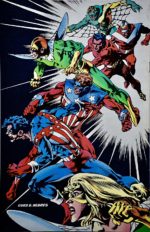 As one might expect, Lance changed into his Shield persona, battled through the horde of little green men, and fought his way past a huge-by-comparison chameleon and wolf. Diablo had restored the Colonel and Georgia to their normal size and was intent on his macro-sized micro-men stuffing them into a capsule and shrinking them into a micro-universe. The Shield, finding a gun that dwarfed him, fired at the savant’s machine, destroying it. He fought Diablo as a mite for a couple of panels before regaining his regular size, but the villain escaped by releasing a horde of lab animals that got in the Shield’s way. Our hero changed back into his Army duds, got the Colonel and Georgia and himself into the newly-expanded atomic tank, and got them the blazes out of there. From his clumsy driving, Georgia deduced that Lance was a nitwit, not like that handsome Shield. Lance smiled.
As one might expect, Lance changed into his Shield persona, battled through the horde of little green men, and fought his way past a huge-by-comparison chameleon and wolf. Diablo had restored the Colonel and Georgia to their normal size and was intent on his macro-sized micro-men stuffing them into a capsule and shrinking them into a micro-universe. The Shield, finding a gun that dwarfed him, fired at the savant’s machine, destroying it. He fought Diablo as a mite for a couple of panels before regaining his regular size, but the villain escaped by releasing a horde of lab animals that got in the Shield’s way. Our hero changed back into his Army duds, got the Colonel and Georgia and himself into the newly-expanded atomic tank, and got them the blazes out of there. From his clumsy driving, Georgia deduced that Lance was a nitwit, not like that handsome Shield. Lance smiled.
But that, too, could be seen as veering too close to Superman / Lois Lane / Clark Kent territory.
That was how Double Life of Private Strong #1 ended, and it was a rip-roaring ride. If Simon and Kirby could have stayed with it, they might have piloted it to greater heights and at least given Archie a base to build on, as with The Fly. But things didn’t turn out that way.
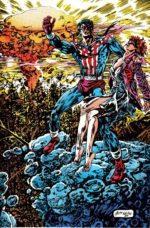 In between his first and second issues, the Shield appeared in a brief two-pager in Adventures of the Fly #1 (August 1959), in which the Fly himself came to Camp Patton in search of the fledgling hero. The Fly wanted him to know that a spy was on the premises, after a secret missile trigger. Behind the insect warrior’s back, Lance Strong changed into the Shield, knocked the spy head-first through a wall, and then returned to civilian guise. The Fly finally caught up to Lance and handed him a picture of the Shield. “What has he done?” asked Lance.
In between his first and second issues, the Shield appeared in a brief two-pager in Adventures of the Fly #1 (August 1959), in which the Fly himself came to Camp Patton in search of the fledgling hero. The Fly wanted him to know that a spy was on the premises, after a secret missile trigger. Behind the insect warrior’s back, Lance Strong changed into the Shield, knocked the spy head-first through a wall, and then returned to civilian guise. The Fly finally caught up to Lance and handed him a picture of the Shield. “What has he done?” asked Lance.
“Nothing yet, Private Strong,” said the Fly, “but he’s up against a tough character—and I don’t want him to get into trouble in my own magazine!” It was a neat bit of cross-promotion.
Private Strong #2 (August 1959) offered us “Lovable Lou, the Toy Master”, who looked somewhat like Sidney Greenstreet and was, of course, secretly in the pay of the Commies. Kirby looked to have laid this one out and fully penciled the splash. After taking Lovable Lou down, the Shield went into a story illustrated by George Tuska, introducing a bumbling Army pal named Pee Wee and a flying tank the Russkies wanted to steal. Tuska continued on into the next story, which concerned a tailor who dreamed about being the Shield, made a similar costume for himself, and had to be rescued from a pair of crooks by the real deal. It was whimsical and fun, but hardly as high-powered as the preceding issue.
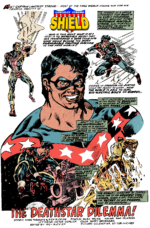 The superhero soldier starred next in a one-page text story in which one General Smith revealed to Lance that he knew he was the Shield. After a Fly two-pager, the Shield was back in a story more firmly drawn by Kirby. “The Ultra-Sonic Spies” saw Lance change to the Shield to save a couple of Army pilots shoved by spies out of an experimental plane. He then flew after the plane, forced the spies to turn back towards America by threatening them with a phony hydrogen bomb, and, as Lance Strong, got a regular chewing-out from the new supporting character, Sgt. Hardrock.
The superhero soldier starred next in a one-page text story in which one General Smith revealed to Lance that he knew he was the Shield. After a Fly two-pager, the Shield was back in a story more firmly drawn by Kirby. “The Ultra-Sonic Spies” saw Lance change to the Shield to save a couple of Army pilots shoved by spies out of an experimental plane. He then flew after the plane, forced the spies to turn back towards America by threatening them with a phony hydrogen bomb, and, as Lance Strong, got a regular chewing-out from the new supporting character, Sgt. Hardrock.
And with that, DC Comics dropped their own bomb on Archie.
Reportedly, they claimed Private Strong was too close to Superman in execution. This was only a few years after they had forced Fawcett to stop publishing Captain Marvel. Beleaguered, and with not much to lose, Archie dropped The Double Life of Private Strong. On the superhero front, they still had The Fly. And of course, they had Archie himself.
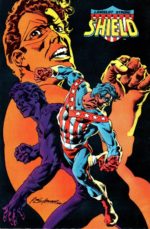 The Shield, however, decided to hang around a little longer.
The Shield, however, decided to hang around a little longer.
In Adventures of the Fly #8 (September 1960), he teamed up with the Fly to take down the Monster Gang, a bunch of thieves dressed as rejects from a Universal horror pic. Our heroes took their lumps until they figured out they were fighting a team of robots, short-circuited them all, and brought the real gang to justice. The art and writing were serviceable, but not spectacular. The Shield ended the story by saying, “I look forward to our next adventure together!” That was sensible, as it was the only outlet he had.
The Shield returned in the next issue (#9, November 1960) to help the Fly battle “The Wizard of Nightmares”. Lance Strong revealed that he and the Fly had told each other of their respective secret identities so they could help each other in emergencies. There was a fine two-page spread in the story, but the tale was pretty generic, and the Shield seemed to bumble a bit.
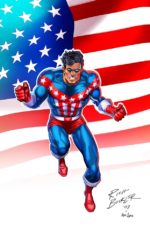 And, like it or not, that was it for Lancelot Strong for a good long while. When a new Shield appeared in Fly Man #31 (May 1965), he was the son of Joe Higgins, the original Shield. Fly-Man, nee’ the Fly, didn’t ask about the Shield he had known, and it may have been just as well.
And, like it or not, that was it for Lancelot Strong for a good long while. When a new Shield appeared in Fly Man #31 (May 1965), he was the son of Joe Higgins, the original Shield. Fly-Man, nee’ the Fly, didn’t ask about the Shield he had known, and it may have been just as well.
Of course, in the world of comic books, hardly any hero with or without potential stays unrevived. The Lancelot Strong Shield finally returned in Mighty Crusaders V2 #1 (March 1983), in a story written and drawn by Rich Buckler. He leaped into action on page 2, beat the heck out of a pack of bad guys, and quickly re-met the Fly, who had Fly Girl and the Jaguar in tow. The Web, the Black Hood, and the Comet also turned up, and the old Shield and new Shield soon got into a rivalry. In between, they fought the Brain Emperor and Eterno the Tyrant. Buckler adapted an origin page from Private Strong #1 in the back for him.
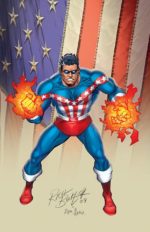 The Lance Strong Shield appeared in Mighty Crusaders V2 #1-4, 6-8, and 10 (May 1983 – December 1984) as a valuable member of the team. He also got his own revival comic, Lancelot Strong, the Shield (#1, June 1983) with a movie-strip cover that echoed the first Double Life cover. But even though Archie was giving all of the Mighty Crusaders their own solo comics, including the first Shield, it was probably thought that two Shields were a bit confusing. Anyway, Stan Timmons and Rich Buckler wrote the first issue, Alan Weiss and Sam Delarosa drew it, and our hero was back in the Army again, this time at Fort Sherman. General Smith was back, his daughter Laureen was introduced, and Lance Strong was back fighting Communist spies in his red-white-and-blues again. He saved Laureen from a baddie named Negatron, and that finished issue #1.
The Lance Strong Shield appeared in Mighty Crusaders V2 #1-4, 6-8, and 10 (May 1983 – December 1984) as a valuable member of the team. He also got his own revival comic, Lancelot Strong, the Shield (#1, June 1983) with a movie-strip cover that echoed the first Double Life cover. But even though Archie was giving all of the Mighty Crusaders their own solo comics, including the first Shield, it was probably thought that two Shields were a bit confusing. Anyway, Stan Timmons and Rich Buckler wrote the first issue, Alan Weiss and Sam Delarosa drew it, and our hero was back in the Army again, this time at Fort Sherman. General Smith was back, his daughter Laureen was introduced, and Lance Strong was back fighting Communist spies in his red-white-and-blues again. He saved Laureen from a baddie named Negatron, and that finished issue #1.
The Shield #2 (August 1983) shoehorned Steel Sterling into the book, as written by Bob Kanigher and drawn by Rudy Nebres. He got the lead spot, and Lancelot Strong was shunted into the back. In that story, the Shield found his powers were running wild, and he feared harming others if they kept increasing. This time he fought a Japanese villain, the Soulless Samurai, in a battle that extended into the next issue.
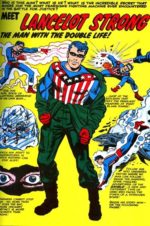 The third issue was titled Shield-Steel Sterling (December 1983), coming some four months after the last one. Bob Kanigher wrote it and Alex Nino drew it. Therein, the Shield took on both the Soulless Samurai and Negatron but had to be operated on for appendicitis in between. Steel Sterling came to visit him, then had to get back on the villain-crushing job. Knowing he was in danger of death if he went back into action so soon post-operation, Lancelot Strong nevertheless put on the uniform again.
The third issue was titled Shield-Steel Sterling (December 1983), coming some four months after the last one. Bob Kanigher wrote it and Alex Nino drew it. Therein, the Shield took on both the Soulless Samurai and Negatron but had to be operated on for appendicitis in between. Steel Sterling came to visit him, then had to get back on the villain-crushing job. Knowing he was in danger of death if he went back into action so soon post-operation, Lancelot Strong nevertheless put on the uniform again.
For the last time.
In an intra-villain battle, Negatron destroyed the Samurai, and the Shield grappled with Negatron in a great underground battle within the San Andreas Fault. It resulted in a huge explosion that raised up a volcanic island. Steel Sterling, looking on, shed a single tear. “I’ll keep the faith…till you come back…Shield!”
And as far as we know, he’s still keeping the faith.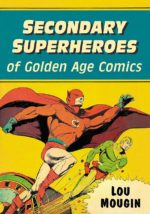
Lou Mougin has written a big comics history book, Secondary Superheroes of Comics’ Golden Age, recently published by McFarland, which covers all MLJ’s 1940s heroes and a whole lot more. He also writes comics and prose for Warrant, Lucky, InDellible, ProSe, Airship 21, AC Comics, and whoever else will let him.


